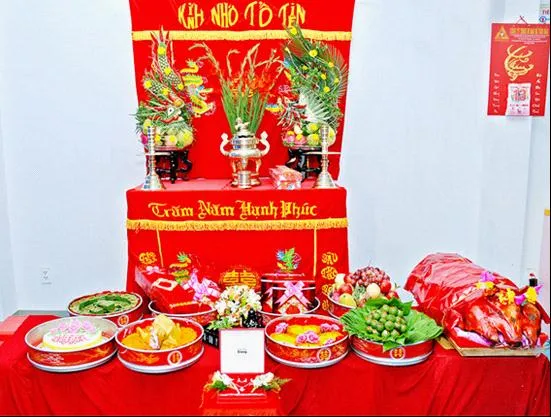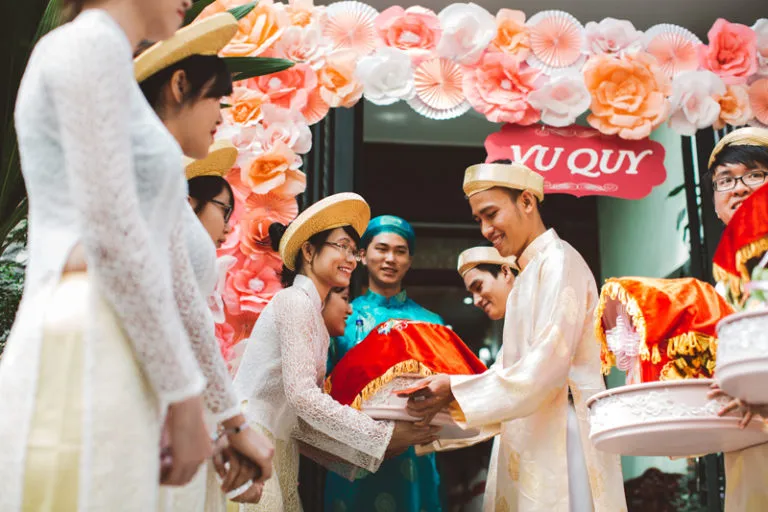Since ancient times, weddings have always been one of the most significant events in the life of every Vietnamese person. More than just a union between two individuals, a wedding is also a connection between two families and lineages, deeply imbued with traditional culture and profound humanistic values. Join “Du lịch khắp thế gian” to explore the unique Vietnamese wedding rituals and understand more about the beauty of Vietnamese culture through generations.
Chạm Ngõ – The Engagement Proposal
The Chạm Ngõ ceremony, also known as the engagement proposal, is the initial step in the Vietnamese marriage journey. This is an opportunity for the two families to officially meet, learn about each other’s backgrounds and lifestyles, laying the groundwork for future family relations. Not requiring elaborate offerings, just a little betel and areca nuts, and fresh fruits, the groom’s family will visit the bride’s family to show respect and express their desire for a marital bond. Although many young families today may skip this ritual to save time, the Chạm Ngõ ceremony still holds an important role in building a strong relationship between the two families.
Lễ Ăn Hỏi – The Betrothal Ceremony
The Lễ Ăn Hỏi, or betrothal ceremony, is one of the most important rituals in traditional Vietnamese wedding culture. This is the day when the two families officially recognize the couple’s relationship, marking a significant step in their journey to build a family.
The groom’s family will prepare a number of betrothal gifts, also known as dowry trays, to bring to the bride’s family. The number of trays is usually odd, symbolizing growth and fertility. Items in the betrothal trays typically include:
- Betel and areca nuts: Symbols of faithful and enduring love.
- Phu Thê cake (Husband and Wife cake): Representing the bond and harmony between husband and wife.
- Cốm cake (Young sticky rice cake): Symbolizing the flexibility and durability of marriage.
- Xôi Gấc (Red sticky rice): The red color symbolizes luck and happiness.
- Roasted pig: A symbol of prosperity and abundance.
- Wine and tea: Showing respect for ancestors.
- Money for engagement: Depending on the economic conditions of each family.
- Jewelry: Given to the bride as a blessing for a wealthy and happy life.

After the bride’s family receives the betrothal gifts, the two families will discuss the wedding date, necessary procedures, and terms related to the young couple’s married life. The Lễ Ăn Hỏi is not only a traditional ritual, but also an opportunity for the two families to show care and love for their children, wishing the couple a happy and fulfilling life.
Lễ Xin Dâu – Requesting the Bride Ceremony
Before the official bride procession, the groom’s family will send a female representative, usually an elder with high standing in the family, to bring a betel box to the bride’s house for the Lễ Xin Dâu ceremony. The bride’s mother will receive the betel box and place it on the ancestral altar to inform the ancestors about her daughter getting married. This ritual shows the groom’s family’s respect for the bride’s family and is also a request to bring the bride to the groom’s house.
Lễ Rước Dâu – The Bride Welcoming Procession
The Lễ Rước Dâu, or bride welcoming procession, is the most important ritual in the wedding, marking the transition from the bride’s family to the groom’s family. The groom, along with the groom’s family, will bring wedding flowers and gifts to the bride’s house to welcome the bride.
Upon arriving at the bride’s house, the groom will present the wedding flowers to the bride, and together they will perform ancestral rituals and greet the bride’s relatives. After that, the bride will officially leave her family and follow the groom to his house, starting a new life.
On this momentous day, both families will give wedding gifts and dowry to the bride and groom as a blessing for a happy and prosperous married life.

Tiệc Cưới – The Wedding Reception
After the bride welcoming procession, both families will host a wedding reception to announce the good news to friends, relatives, and colleagues. The wedding reception is an opportunity for everyone to celebrate and wish the young couple happiness.
Currently, many families hold a joint wedding reception after the bride welcoming ceremony concludes. However, some families still maintain the tradition of holding separate receptions. The bride’s family usually hosts a reception before the groom’s family comes to welcome the bride, and the groom’s family will host a reception after the bride is introduced to his relatives.
Lễ Lại Mặt – The “Returning Face” Ceremony
After the wedding, when the bride has arrived at the groom’s house, the mother-in-law will prepare a small offering tray for the bride and groom to bring back to the bride’s house for the Lễ Lại Mặt, also known as the “returning face” ceremony or Nhị Hỷ ceremony. This is an opportunity for the bride and groom to show filial piety and gratitude to the bride’s parents, and also an opportunity for the two families to become closer and more affectionate. The Lại Mặt usually takes place 1-3 days after the wedding, depending on the geographical distance and the couple’s circumstances.

Preserving and Promoting Cultural Values
Vietnamese traditional wedding culture is a priceless treasure, containing profound humanistic values. Preserving and promoting these values not only helps us maintain our national cultural identity but also contributes to building a better society. Despite many changes in modern life, traditional wedding rituals still hold an important place in the spiritual life of Vietnamese people, serving as a connecting thread between the past, present, and future.